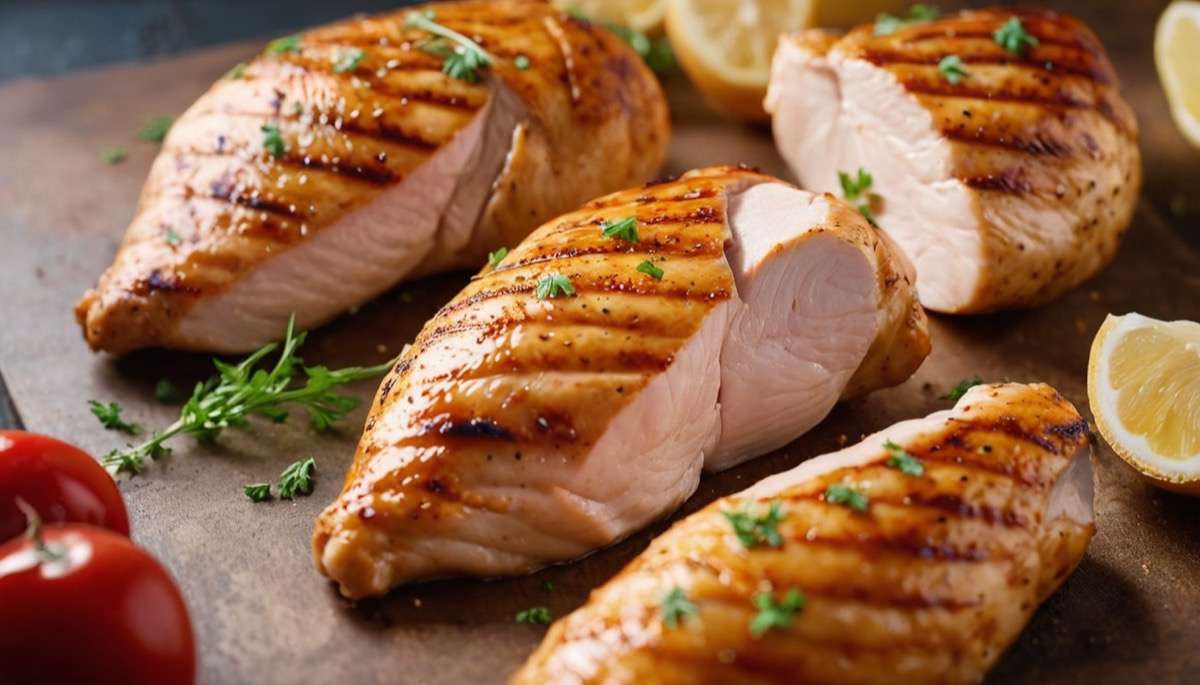Discover the calorie count of chicken breast and other cuts. Understand the factors affecting calories and learn healthy cooking techniques. Make informed dietary choices for a balanced lifestyle.
In this informative article, you will discover the precise number of calories present in different parts of chicken, with a particular focus on the commonly consumed chicken breast. Whether you are looking to maintain a healthy diet or are a fitness enthusiast, understanding the caloric content of chicken is essential for making informed food choices. By delving into the calorie count of chicken breast and other popular cuts, you’ll gain valuable knowledge that can assist you in maintaining a balanced lifestyle.

Types of Chicken Cuts
Chicken is a versatile and popular protein choice, and it comes in various cuts. Each cut has its own unique characteristics and can be prepared in different ways to create delicious meals. The most common types of chicken cuts include Chicken Breast, Chicken Thigh, Chicken Wing, Chicken Drumstick, and Chicken Skin. Let’s explore each cut in more detail to give you a better understanding of the different options available.
Chicken Breast
Chicken Breast is arguably the most popular and widely consumed cut of chicken. It is known for its lean meat and versatile cooking options. Chicken breasts are boneless and have low amounts of fat, making them a healthy choice for many individuals. This cut is also very versatile, as it can be grilled, baked, poached, or sautéed to create a wide variety of dishes.
Chicken Thigh
Chicken Thigh is another commonly enjoyed cut of chicken. It is darker and more flavorful than the chicken breast, primarily due to the higher fat content. The thigh is slightly more tender and moist compared to the breast, which can make it a preferred choice for certain recipes. Chicken thighs are often baked, grilled, or pan-fried to enhance their rich flavor.
Chicken Wing
Chicken Wings are a favorite among many people, especially when it comes to finger foods and game day snacks. These small, bone-in cuts are known for their deliciously crispy skin and tender meat. Chicken wings can be cooked in various ways, such as baking, frying, or grilling. They are often served with a variety of sauces and seasonings to enhance their flavor.
Chicken Drumstick
Chicken Drumsticks are another popular cut that is loved for its tender meat and juicy flavor. These cuts are taken from the lower part of the chicken leg and are typically bone-in. Chicken drumsticks are often marinated and baked, grilled, or fried to create a crispy outer layer while maintaining the moistness of the meat inside.
Chicken Skin
While not technically a cut of chicken on its own, Chicken Skin is often used in cooking to add flavor and texture. It is the fatty and flavorful outer layer that covers the chicken meat. Chicken skin can be cooked separately to create crispy skin snacks or used to baste and flavor other cuts of chicken during cooking.
Calories in Chicken Breast
Calorie Content
When it comes to tracking your calorie intake, understanding the calorie content of different chicken cuts is essential. Chicken breast is a lean cut, making it a popular choice for those watching their calorie intake. A skinless, boneless chicken breast typically contains around 165-180 calories per 100 grams. However, it’s important to note that the number of calories can vary based on the size and cooking method.
Cooking Methods
The way you cook your chicken breast can influence its calorie content. Grilling or baking the chicken breast without adding any additional fats or oils can help maintain its low-calorie profile. On the other hand, cooking methods that involve frying or adding butter or oil can increase the calorie content significantly. It is important to be mindful of the cooking techniques you use to achieve your desired calorie intake.
Skinless vs. Skin-on
Removing the skin from the chicken breast can significantly reduce its calorie content. Chicken skin contains a high amount of fat, which increases the overall calorie count. By opting for skinless chicken breast, you can enjoy the lean protein benefits without adding unnecessary calories. However, some individuals may prefer cooking chicken breast with the skin on to add moisture and flavor, but it’s important to account for the extra calories.
Seasonings and Sauces
The seasonings and sauces you use to enhance the flavor of your chicken breast can also impact its calorie content. Some seasonings and sauces may contain added sugars, fats, or high-calorie ingredients. It’s essential to choose seasonings and sauces that are low in calories or use them sparingly to maintain the overall calorie count of your chicken breast dish.
Health Benefits of Chicken Breast
Chicken breast offers several health benefits, making it a nutritious choice for individuals looking to maintain a balanced diet and improve their overall well-being. Let’s explore some of the key health benefits of consuming chicken breast.
High Protein
Chicken breast is an excellent source of high-quality protein. Protein plays a crucial role in various bodily functions, including muscle repair, growth, and maintenance. Consuming an adequate amount of protein can also help you feel satiated, which may aid in weight management. Including chicken breast in your diet provides a lean and easily digestible protein source.
Low Fat
Chicken breast is a lean cut of meat, meaning it contains low amounts of fat compared to other cuts. By choosing skinless chicken breast and trimming any visible fat, you can reduce the overall fat content even further. A lower fat content can contribute to maintaining a healthy weight, reducing the risk of cardiovascular diseases, and promoting overall heart health.
Nutrient Profile
In addition to being a great source of protein, chicken breast offers several important nutrients. It contains essential vitamins such as B vitamins (including niacin and vitamin B6) and minerals like selenium and phosphorus. These nutrients play vital roles in energy metabolism, immune function, and maintaining healthy bones and teeth.
Factors Affecting Calories in Chicken Breast
Several factors can influence the calorie content of chicken breast. Understanding these factors can help you make informed decisions about the chicken breast you consume and how it is prepared.
Breed and Quality
The breed of chicken and its quality can affect the fat content and overall calorie count of the meat. Different breeds may have varying levels of fat within the meat, which can impact the calorie content. Additionally, the quality of the chicken, such as its diet and living conditions, can also influence its nutritional composition.
Cuts and Portions
Different cuts of chicken breast can vary in their calorie content. Skinless, boneless chicken breast typically has the lowest calorie count compared to cuts with the skin and bone. Additionally, the portion size of the chicken breast can affect its calorie content. A larger portion will naturally have more calories compared to a smaller portion.
Cooking Techniques
The cooking techniques used can influence the calorie content of chicken breast. Methods such as grilling, baking, or broiling without adding additional fats or oils can help maintain a lower calorie count. On the other hand, cooking methods that involve frying, breading, or adding butter or oil can significantly increase the calorie content.

Comparative Analysis
When making dietary choices, it’s helpful to compare different options to determine the best fit for your nutritional needs. Let’s explore how chicken breast compares to other chicken cuts and other common sources of protein.
Chicken Breast vs. Other Chicken Cuts
Chicken breast is often chosen as a preferred option for individuals aiming to maintain a lower calorie intake or reduce fat consumption. Compared to other cuts like chicken thigh, drumstick, or wing, chicken breast generally has a lower fat content and calorie count. However, it’s important to note that the taste and texture of the other cuts may be preferred in certain recipes or by individual preferences.
Chicken Breast vs. Other Proteins
When compared to other common protein sources such as beef, pork, or lamb, chicken breast is generally lower in calories and fat. It offers a lean and nutritious option for individuals looking to incorporate protein into their diet without excessive fat intake. However, the specific nutrient profile and benefits of each protein source may vary, and it’s important to consider the overall balance of your diet.
Tips for Healthy Chicken Breast Consumption
To make the most of your chicken breast consumption while maintaining a healthy and balanced diet, here are some essential tips:
Trimming Excess Fat
When preparing chicken breast, trim any visible fat or skin before cooking. This simple step can help reduce the overall calorie and fat content of the dish.
Choosing Lean Cuts
Opt for skinless, boneless chicken breast whenever possible to keep the calorie count lower. Removing the skin can significantly reduce the fat content.
Avoiding Deep Frying
Deep frying chicken breast can significantly increase its calorie content due to the added oil. Opt for healthier cooking methods like grilling, baking, or broiling to reduce the overall calorie count.
Pairing with Wholesome Sides
To create a balanced meal, pair your chicken breast with nutritious sides such as steamed vegetables, whole grains, or salads. These additions can enhance the nutritional value of your meal and provide a variety of essential nutrients.

Chicken Breast Recipes with Calorie Information
If you’re looking for delicious and healthy ways to enjoy chicken breast, here are a few recipes to try:
Grilled Lemon-Pepper Chicken Breast
Ingredients:
- Skinless, boneless chicken breasts
- Freshly squeezed lemon juice
- Black pepper
- Salt
- Olive oil
Calories per serving: Approximately 150-200 calories
Instructions:
- Preheat the grill to medium-high heat.
- In a bowl, combine the lemon juice, black pepper, salt, and olive oil.
- Marinate the chicken breasts in the mixture for at least 30 minutes.
- Place the chicken breasts on the grill and cook for approximately 6-8 minutes on each side, or until the internal temperature reaches 165°F (74°C).
- Remove from the grill and let the chicken breasts rest for a few minutes before serving.
Baked Garlic-Parmesan Chicken Breast
Ingredients:
- Skinless, boneless chicken breasts
- Garlic powder
- Grated Parmesan cheese
- Salt
- Black pepper
Calories per serving: Approximately 180-220 calories
Instructions:
- Preheat the oven to 400°F (200°C).
- Season the chicken breasts with garlic powder, grated Parmesan cheese, salt, and black pepper.
- Place the chicken breasts on a baking sheet lined with parchment paper.
- Bake for approximately 20-25 minutes, or until the internal temperature reaches 165°F (74°C).
- Remove from the oven and let the chicken breasts rest for a few minutes before serving.
Roasted Rosemary Chicken Breast
Ingredients:
- Skinless, boneless chicken breasts
- Fresh rosemary sprigs
- Garlic cloves
- Olive oil
- Salt
- Black pepper
Calories per serving: Approximately 160-200 calories
Instructions:
- Preheat the oven to 375°F (190°C).
- Place the chicken breasts in a baking dish.
- Drizzle olive oil over the chicken breasts and season with salt, black pepper, minced garlic, and fresh rosemary sprigs.
- Bake for approximately 25-30 minutes, or until the internal temperature reaches 165°F (74°C).
- Remove from the oven and let the chicken breasts rest for a few minutes before serving.
In conclusion, chicken breast is a versatile, low-calorie protein option that offers several health benefits. Understanding the calorie content, cooking methods, and factors that can affect the calorie count is essential for making informed dietary choices. By incorporating chicken breast into your meals and following the tips for healthy consumption, you can enjoy delicious and nutritious dishes while maintaining a balanced diet.


